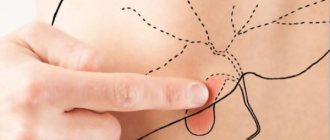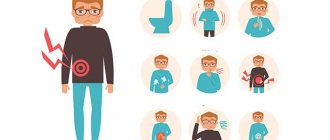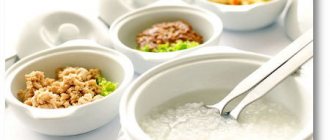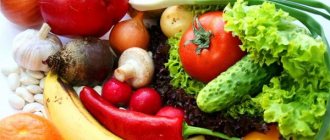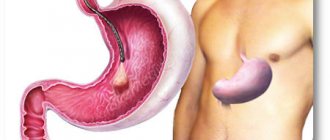Basic rules and principles of diet
Polyps can be detected both in the stomach and intestines (colonoscopy determines their presence).
The peculiarities of the diet are that it is necessary to exclude from the diet those foods that can harm the mucous membranes of the digestive tract. They should also be prevented from being exposed to irritating factors (mechanical, thermal or chemical).
The diet after removal of the stomach polyp and other formations on the mucous membrane should ease the burden on the digestive organs. If you do not follow it, the recovery processes in the body will be disrupted. This operation involves removing part of the mucous membrane.
Digestive enzymes cannot be produced in the required quantities, so failure to follow the diet can lead to serious consequences.
Large pieces of food can take a long time to digest, resulting in fermentation and rotting processes in the stomach. You should not eat food in large portions, because... this contributes to the release of a large number of enzymes, which complicates the functioning of the digestive tract.
The level of stomach acidity plays an important role when choosing dietary nutrition. With low acidity, the diet should contain foods that stimulate the production of gastric juice: first and second courses cooked in concentrated meat or mushroom broths, as well as ham, vegetables, cheese, pasta, sausage (boiled), spicy seasonings.
With high acidity, the diet should consist of lean dishes: soups with meat or vegetable broths, mashed potatoes, slimy porridges (except corn, wheat and barley).
For the first 2 weeks after surgery, it is recommended to adhere to a gentle diet to avoid exacerbation. Most often, at the initial stage of recovery, the acidity level is elevated. It can be corrected with a diet of lean dishes.
Food must be subjected to minimal heat treatment. The most suitable cooking methods are baking and boiling. But in the first 15 days after surgery, doctors recommend eating steamed dishes. Ingredients that will be steamed should be chopped as finely as possible. For preparing meat dishes, it is best to use minced meat.
It is allowed to consume vegetable soups in meat broth with the addition of cereals and lean meat. During the first 10 days of the postoperative period, you can eat meat broths (when preparing them, the water must be drained 3 times). Vegetables should be present in the soup in grated form.
During the rehabilitation period, it is best to use buckwheat and oatmeal, millet, and rice.
Regardless of the method of preparing dishes, salt should be present in a minimum amount. For various diseases of the gastrointestinal tract, the maximum amount of salt consumed per day should be no more than 10 g. The situation is similar with sugar. It is not recommended to consume more than 1 tsp. sugar per day. If you can’t completely eliminate sugar, you can replace it with honey, but not more than 1 tsp. in a day.
The use of hot seasonings is prohibited, because... they increase the production of enzymes, which negatively affects the mucous membrane.
You should limit your consumption of low-fat foods and dishes so as not to provoke irritation of the mucous membranes of the digestive organs.
The diet can be supplemented with enzyme preparations as prescribed by a doctor.
Diet after endoscopic polypectomy
On the day of the operation, you cannot eat at all; for the next day, only liquid food. Then you need to eat a special diet for a month.
The main task of special nutrition during this period is not to harm the affected stomach. Therefore, food must meet the following requirements:
- Consistency. Liquid, semi-liquid, pureed, crushed or mashed food.
- Temperature. The ready-to-eat dish should have a temperature of 36–37⁰. Sudden changes can damage the mucous membrane of the affected stomach.
- Cooking method. Only boiling, steaming or stewing. Fried foods are strictly prohibited. Baking is permissible if the top crust is removed before use.
- Mode. The frequency of special meals is very important; it is recommended to eat at least 6 times a day.
- The volume of the dish should be small. During the first days, food is consumed several times per hour, 1–2 tablespoons. After a week, portions are increased based on individual needs. Stretching the affected stomach due to a large amount of food is unacceptable.
- Water mode. After surgery, you need to drink enough water, at least 2 liters per day, but in small portions and separately from meals.
What products are welcome?
We are talking about therapeutic or rehabilitation special nutrition, so the principles for choosing products are much more stringent. Let's look at the ingredients and dishes that will help you recover:
- Soups and broths, vegetable, with lean meat or fish.
- Kissels without acid content. The best choice would be oatmeal jelly - it's just an elixir for an affected stomach.
- Fermented milk products are very useful for restoring healthy flora on the organ mucosa. A small amount of cheese is allowed and not every day.
- The meals are mostly carbohydrate with a minimum of fat and protein for the first week.
- Puree of boiled vegetables will help the body get the necessary microelements.
- Lean meat, poultry, fish, soft-boiled eggs (once a week) are a source of protein for restoring the body in the postoperative period.
- You can only eat “yesterday’s” bread, because fresh bread increases the acidity of gastric juice.
- Porridges and side dishes made from boiled cereals form the basis of a special diet. They can be cooked with water or milk. The main condition is that the grains must be well boiled.
- Olive and sunflower oils will help absorb vitamins and protect the lining of the affected stomach.
What should you watch out for?
It is clear that you should not eat hot, rough food, but what other restrictions are there? List of foods that are prohibited for dietary purposes:
- Milk is not recommended for the first week after surgery, and further use is preferable only for cooking.
- Salt is completely excluded after surgery and introduced into the diet gradually.
- Sausage and smoked products are strictly prohibited.
- Canned food, including homemade pickled vegetables, can cause a chemical burn to the mucous membrane of the affected stomach.
- Raw vegetables and fruits.
- Citrus fruits and berries with a sour taste.
- Drinks from the store - packaged juices, soda. They contain citric acid.
- Fatty foods.
- Coffee and strong tea irritate the mucous membrane of the affected stomach.
- All ingredients that cause bloating are prohibited. These are cabbage, peas, beans, beans.
- Yeast baked goods start the fermentation process.
- Alcoholic beverages should not be drunk under any circumstances.
- Smoking is not related to nutrition, but has a huge pathogenic effect on the affected stomach.
Attention! It is better to ask your doctor about products that raise doubts. During the rehabilitation period, even a harmless product can lead to serious problems.
List of allowed products after surgery
Nutrition for gastric polyps should be gentle. It is necessary to know healthy and harmful foods for the gastrointestinal tract.
During the first month of the rehabilitation period, the menu should be based on pureed soups and slimy porridges, dishes with a high protein content, which will promote rapid cell regeneration.
Meat dishes you can eat:
Fish dishes should be prepared from lean fish. The range of dishes is similar to meat dishes.
For acute and chronic pancreatitis, pumpkin is the best dietary product.
When treating gastrointestinal diseases, the menu should include the following vegetables:
It is recommended to grind them in a blender until the consistency of puree.
Nutrition after removal of polyps in the stomach consists of eating small amounts of the following foods:
- lean meat;
- soups from well-cooked cereals;
- porridge (except white rice);
- broths on meat (second and third broth);
- wheat crackers (unsweetened);
- boiled fish (low-fat);
- kefir;
- low-fat cottage cheese;
- butter.
It is recommended to drink black tea (strong).
Drinking rosehip decoction will be beneficial.
Following a postoperative diet may pose a risk of relapse. Then the necessary products in the patient’s diet become:
- milk;
- dairy products;
- red fish;
- cereals;
- cabbage (helps fight pathogens in ulcers and wounds);
- vegetables and fruits;
- soups and salads with the addition of vegetable oil;
- green tea.
General principles of diet
For all types of polyps in the stomach area, the doctor prescribes a special diet. It is important to understand that diet treatment is always long-term and must be combined with an absolutely healthy lifestyle.
The therapy is based on the following aspects:
- Meals should be small but frequent (small portions 5-6 times a day);
- All products must be steamed or boiled;
- It is important to consume no more than 2800 Kcal per day;
- Drinking regime is no more than 2 liters per day.
There should not be long breaks between meals, as hunger stimulates the production of hydrochloric acid. Acidic components destroy the polyp, promote its ulceration, and stimulate hyperplasia of the gastric mucosa.
People with gastrointestinal problems need to know that healthy nutrition:
- reduces pain;
- normalizes appetite;
- completely eliminates heartburn, vomiting, nausea;
- increases the absorption of all beneficial microelements.
Note! The advantage of dietary nutrition is the ability to prevent cancerous transformation of cells.
What fruits and vegetables can you eat?
Vegetables contain a large amount of vitamins, essential microelements and fiber. Pectins, found in almost all vegetables, coat the walls of the stomach, preventing damage.
It is recommended to eat if you have a polyp:
- potato;
- zucchini or zucchini;
- carrots with cream;
- pumpkin;
- white and cauliflower;
- all the greens.
Vegetables can be eaten boiled or fresh. Nutritionists recommend combining freshly squeezed juices with cream or full-fat milk (for example, 1 tablespoon per 250 ml of juice), adding herbs and celery to the juice. However, it is important to observe moderation and drink no more than 300 ml of juice per day.
Fruits are an important part of the diet - they are a storehouse of vitamins, minerals, and fiber. For gastric polyposis, fruits are recommended that do not irritate the mucous membrane and stimulate appetite.
Here is their list:
- Bananas are a hearty fruit, the components of which envelop the mucous membrane and protect from damage;
- Pear - should be eaten peeled for easier digestion;
- Apples, a healthy fruit for polyposis, are recommended to be processed thermally: baked, boiled as compote;
- Plum - it is important to eat ripe sweet fruits with a minimum amount of acid;
- Watermelon - the berry has almost no sugar, and the pulp is neutral with respect to the acidic component;
- Persimmon is a very healthy fruit that has an astringent effect and protects against the negative effects of internal factors;
- Avocado does not contain acid, but it contains many healthy oils and vitamins.
Berries are an excellent addition to fruit.
Especially useful for polyps:
- strawberry,
- cherries,
- sweet cherry,
- blueberry,
- lingonberries and cranberries.
Fruits and berries go well with honey, cottage cheese, and kefir.
For good absorption, it is better to eat fruits with fermented milk and dairy products.
Table for a week
Sample menu for polyps for a week:
- Monday . For breakfast, oatmeal, tea with milk, 2 teaspoons of honey. For lunch, a salad of fresh vegetables with butter, broth with chicken breast. For dinner, buckwheat with butter without adding salt. For drinks, it is recommended to drink green tea and water.
- Tuesday . Casserole of low-fat cottage cheese with dried apricots, decoction of rose hips. Vegetable salad with sour cream, broth, egg for lunch. Steam cutlet, dried fruit compote for dinner. Snack on their bread and rosehip broth.
- Wednesday _ Diet gingerbread and a glass of warm milk with honey for breakfast. For lunch, vegetable salad with herbs and meat broth. For dinner, buckwheat without salt. Snacks - milkshakes and bread.
- Thursday . Buckwheat with milk and tea with milk for breakfast. Steam cutlet with mashed potatoes for lunch. For an afternoon snack, milk and gingerbread. For dinner, cottage cheese casserole with sour cream and milk. Snacks - dried apricots, prunes, compote.
- Friday . Semolina porridge with milk, sandwich with butter, milk. For lunch, chicken fillet with vegetables and rosehip broth. For dinner, rice and fish cake. Instead of snacks, you can drink green tea, chamomile or rosehip infusion.
- Saturday . A light breakfast of any milk porridge, banana puree, tea with milk. Vegetable soup with chicken and noodles for lunch, apple compote. For dinner, milk noodle soup, rosehip infusion. Gingerbread cookies, milk, and crackers are suitable as snacks.
- Sunday . Sandwich with butter and coffee with milk. Cottage cheese casserole for second breakfast. Mashed potatoes and stewed fresh cabbage, and a decoction of rose hips. For dinner, yogurt or kefir.
The sample menu can be modified, changed places or days. The main thing is that meals should be taken once every 2-3 hours in small portions. Food should be homemade, steamed or boiled.
List of prohibited products
Diet for polyps in the stomach and in the postoperative period is an effective and necessary factor for the restoration of the body.
In this regard, you should avoid the following foods and drinks:
- spicy, salty and fried foods;
- smoked meats;
- bread and bakery products (butter);
- white cabbage;
- peas;
- seasonings and spices;
- milk (fresh);
- carbonated drinks;
- juices (in packages);
- coffee;
- alcohol.
It is undesirable to use these products for any diseases of the gastrointestinal tract.
Sample menu
Food should contain large amounts of vitamins and minerals.
Doctors recommend eating dietary food after removal of polyps in the stomach or duodenum, and a sample menu is as follows:
- Breakfast: 2 eggs (boiled), tea.
- Second breakfast: buckwheat porridge, fruit drink.
- Lunch: fish soup, cottage cheese soufflé, bread, compote.
- Afternoon snack: 2 baked apples (can be replaced with pears), tea.
- Dinner: boiled meat, baked vegetables, juice, bread.
You can create your own menu from the list of products allowed for consumption.
Polyps are a benign type of neoplasm that can occur throughout all mucous membranes. They are often found in gastroenterology, but are not clinically manifested in any way. Usually, the formation of polyps on the gastric mucosa is determined during a routine examination of the organ’s condition or during the diagnosis of other diseases.
According to statistics, people aged 40+ suffer from this disease. Men are most susceptible to the formation of polyps in the stomach. The cause of the appearance of neoplasms is the bacteria Helicobacter pylori, gastritis or heredity. Treatment usually involves removing them.
Removal methods
The danger of a neoplasm lies, as already mentioned, in the fact that over time it can develop into a malignant tumor. That is why timely diagnosis, competent therapy or removal of a polyp in the stomach is required.
Initially, drug treatment is used. It involves the use of medications that coat the walls of the stomach, as well as dietary supplements that help stimulate digestion. In addition, the use of drugs is required that will help eliminate the inflammatory process.
If long-term drug treatment does not bring any results, then the polyp in the stomach is removed. It is carried out using two main technologies:
- endoscopic;
- full surgical intervention.
The first is used if it is necessary to remove single tumors and when the damage to the mucosa is minor. In especially severe cases, open surgery is prescribed, as well as excision of several parts of the stomach.
Symptoms of polyp formation
The early stages of polyp development are completely asymptomatic. If the neoplasms provoke gastritis or other gastrointestinal diseases, then a number of classic signs are observed, which mainly appear immediately after eating or after an hour or two: broken stools; flatulence and belching; vomiting and nausea; increased salivation; decreased appetite; dull and aching pain in the abdomen; feeling of fullness in the stomach; heaviness in the stomach area.
If you do not pay attention to the symptoms in the early stages, in the future it will be accompanied by pain in the lower back or shoulder blades, general weakness, and fever. Larger polyps can cause bleeding, which will lead to severe vomiting of blood. After the polyps grow into the duodenum, cramping pain in the abdominal area and under the breasts may occur.
Is surgery necessary?
It is necessary to remove polyps, as they can provoke the development of quite serious complications.
- strangulation of polyps with accompanying severe pain;
- disruption of the gastrointestinal tract;
- infection;
- stomach bleeding.
Among the most dangerous complications: transition from a benign neoplasm to a malignant one. Degeneration into cancer occurs in 90 percent of total polyposis (a case where the number of polyps cannot be counted).
The more gastric mucosa is covered with polyps, the higher the likelihood of degeneration into cancer. Polypous stomach cancer is called carcinoma. The presence of risks of degeneration into a malignant tumor, as well as damage to a large area of the gastric mucosa, is an automatic indicator for surgical manipulation.
It is worth understanding that carcinoma is formed not only from large polyps; therefore, during the removal process, small tumors should not be ignored. In medicine, there are cases when apparently benign tumors turned out to have malingia of the villi (already degenerated into malignant ones).
Cancer is a very unpredictable disease, therefore, it is important to completely remove the polyposis during surgery.
Polyps can be identified during:
- Ultrasound diagnostics with contrast;
- x-ray diagnostics;
- MRI;
- CT;
- gastroenteroscopy.
Patients who have a chronic or congenital form of gastrointestinal diseases are at risk of polyposis and need regular endoscopy in order not to miss the onset of neoplasms. The doctor can finally say whether this formation is benign or malignant only after surgery, as well as histology and cytology of cells and tissues.
Is it necessary to remove a polyp in the stomach?
When a polyp is identified in the upper parts of the digestive tract, the doctor and patient are faced with the question: what tactics should be chosen? The treatment method depends on the data obtained as a result of FGDS with a biopsy.
Polyp in the stomach: what is it, is it dangerous, how to treat
A conservative approach with dynamic observation is used if the size of the formation does not exceed 5 mm and is not accompanied by malignant degeneration of surrounding tissues. If the value is 6-9 mm and it does not bother you, a decision is made based on clinical and histological data. In this case, drug therapy is prescribed followed by endoscopic monitoring after 6-12 months.
Surgery is necessary when the size of the formation is more than 1 cm. Its location in the area of the pyloric and cardiac sections of the stomach is also unfavorable - polyps can interfere with the normal movement of food into the underlying sections.
How long the preparation for removal and the operation itself will take depends on the chosen method of surgical intervention, the general condition of the patient, concomitant pathologies and the risk of complications. The technique is determined taking into account the size of the formation, the number of polyps, histological type, and the presence of metaplasia of the mucous membrane around the pathological area.
Treatment tactics
Treatment for polyposis in the stomach is aimed at removing it and preventing any further complications. With the help of drug therapy, neoplasms cannot be eliminated; medications will only help stop the inflammatory process.
In the presence of hyperplastic polyps with a size of less than 20 millimeters, doctors can use a wait-and-see approach with the use of anti-inflammatory medications, acid-regulating drugs, antibiotics and a special diet. In the first weeks, it is important to perform gastroendoscopy regularly in order to monitor changes in the size of polyps and the appearance of new ones.
Basics of dietary nutrition after removal of a gastric polyp
Any of the methods for eliminating pathological growth of the mucous membrane leads to a violation of tissue integrity. Therefore, during this period the patient needs special nutrition. The diet after removal of a gastric polyp by endoscopy or abdominal surgery depends on the area of the wound surface and the level of acidity. However, there are general approaches to diet in such patients, which are presented:
- Hunger break in the first hours after invasive intervention.
- Gradual expansion of nutrition.
- Ensuring there is enough fluid.
- By first introducing dishes with a liquid consistency, followed by a transition to semi-liquid, viscous food.
- By including carbohydrate-based foods in the early days and then adding proteins and fats.
- Excluding food that can irritate the mucous membrane mechanically, chemically, or thermally.
- Choosing the optimal amount of nutrition depending on the treatment option.
Rehabilitation
Be sure to see a doctor after 2 weeks for a follow-up examination. After abdominal surgery, control diagnostics are prescribed after 30 days. It is important after the procedure to adhere to a diet without fatty, spicy, bitter, sour and heavy foods for at least 12 months (table No. 1). After abdominal surgery, you should not lift heavy objects; it is recommended not to make sudden movements or overstrain the abdominal area for a month.
Polyps are benign neoplasms that can become malignant over time. If the growths are small, they are simply monitored. However, all tumors begin to grow over time. In this case, polyps in the stomach are removed through surgery. There are several varieties of them.
When Removal is Required
Sometimes, when tumors occur, a very clear clinical picture is observed. So, when it is pinched, sharp pain may occur in the epigastric region, radiating to other parts. In this case, an urgent examination and well-chosen treatment are required.
Based on the results of the study, the issue of removing the polyp in the stomach is decided. There are certain indications for surgical intervention:
- if, in the absence of clinical manifestations, the polyp is hyperplastic;
- in the absence of clinical manifestations, the neoplasm is adenomatous;
- there are severe symptoms;
- rapid growth of the tumor is observed, as well as a change in its shape.
The need to remove polyps in the stomach is decided strictly individually for each patient. In this case, it is necessary to take into account the characteristics of the neoplasm and the general well-being of the patient.
Clinical manifestations and main indications for surgery
At first, the developing polyps do not manifest themselves at all, or short-term symptoms appear, which the person does not pay attention to or confuses with others. Similar signs are present in gastritis, peptic ulcer disease, or during exacerbation of pathologies. The main symptoms of polyps include:
- bloating;
- heaviness in the stomach;
- hidden blood in stool;
- increased salivation with high production of gastric juice;
- dyspeptic disorders (nausea, vomiting, diarrhea);
- decreased or loss of appetite;
- flatulence;
- stomach pain;
- weight loss.
If tumors are pinched, acute attacks of pain in the abdomen or under the chest may occur. They are rare and can be easily treated with medication. As tumors increase, gastric bleeding appears.
Indications for surgery
It is believed that the main indications for surgical intervention are the results of biopsy and histology. However, a biopsy is often performed for the first time during surgery to eliminate the risks of infection, complications and damage to the polyp. Indications for surgical intervention are:
- multiple large tumors;
- exacerbation of certain gastric pathologies;
- frequent relapses after drug treatment;
- emergence of a risk of malignancy;
- rapid growth of tumors (more than 2 cm);
- impossibility of treatment with medications;
- burdened anamnesis.
Open surgery
If the size of the tumor reaches 3 cm or more, it is located on a broad base, or there is a suspicion that the tumor is malignant, abdominal surgery is performed. Also, an indication for surgical polypectomy is several solitary polyps, which are located at a short distance from each other.
Attention! Photo of shocking content. To view, click on the link.
At the initial stage, the patient is put under general anesthesia. Then the tissues are dissected and the formations are removed using a scalpel. Materials must be sent for histological examination. After which the tissues are sutured layer by layer, and the patient is brought out of anesthesia.
Neoplasms complicated by necrosis, with a pinched leg, or located within the pyloric region and causing obstruction are removed along with part of the stomach. Resection is also carried out if the tumor formation is malignant.
This involves removing part or the entire antrum of the stomach. There are many options for the operation, but the most well-known methods include resection according to Bilbort I or Bilbort II (the remaining part of the organ is connected to the duodenum end to end or side parts).
Complications of this operation include:
It consists of the accelerated movement of food, mainly carbohydrates, from the stomach to the intestines without proper digestion. It manifests itself as attacks of general weakness during meals or during the first 15–20 minutes after eating. It begins with a feeling of fullness in the epigastrium and may be accompanied by drowsiness, dizziness, and tinnitus.
Metabolic disease
The patient loses weight sharply with normal nutrition
This is one of the most serious complications when a patient develops cancer in the remaining part of the stomach.
Removal of gastric polyps
There are several methods of surgery to remove polyps in the stomach. The choice is up to the doctor. It is impossible to cure polyps with medication. Therapy is aimed at relieving inflammation, negative symptoms, and stopping the growth of tumors. If the polyps are less than 2 cm, then expectant management is used. Anti-inflammatory and antimicrobial agents are prescribed.
Adenomatous, hyperplastic growths are subject to surgery, especially if they grow quickly. Endoscopic intervention is often used when polyps are excised without damaging the skin. The safest method is laser surgery. It is considered a minimally invasive method. Sometimes abdominal surgery is used. However, it is now rarely used, as there are less invasive techniques.
Endoscopic surgery
These operations have several varieties, which are performed using a special device - an endoscope, which is inserted into the stomach. The equipment is equipped with a mini camera that allows you to monitor all actions on the monitor. The polyp is then cut off with instruments.
The operations are performed under anesthesia. Its type and dosage are selected individually. Small polyps can be removed without anesthesia. Types of endoscopic operations:
- Electroagulation . Electric current is used during this operation. Forceps are advanced towards the polyps, to which electricity is supplied. As soon as the instruments approach the growths, their tissues are heated and the sore spots are evaporated. This method is used for polyps less than 1 cm in diameter.
- Electric excision . The tumor is removed using a small loop. She attacks the polyp. Then a current is passed through the loop. As a result, when cutting polyps, damaged tissue is simultaneously cauterized. However, this operation cannot be used for multiple formations, since they are removed in parts.
- Gastric polypectomy (endoscopic). During this operation, the polyp is cut off mechanically using special instruments. In this case, there is no need to cauterize the tissue, since bleeding is eliminated.
Endoscopic operations are performed simply and quickly. Often, even anesthesia is not required. However, the listed operations are used only to remove small polyps. Moreover, the intervention can be performed several times. After such interventions, the patient leaves the hospital within 4 hours.
However, there are also small disadvantages - the risk of damage to the gastric mucosa and the growth of a new polyp. Endoscopic operations are not performed in the presence of a cardiac pacemaker, defibrillator, poor blood clotting, or in the presence of diffuse types of neoplasms.
Laser therapy
The laser method of polyp removal is considered the most gentle. A special tube is inserted into the endoscopic equipment. A laser beam is directed through it, which evaporates the pathological layers one by one.
The laser penetration depth and impact accuracy are strictly controlled. After completion of the procedure, the vessels are sealed, which prevents possible bleeding. The tissues heal in 10 days. However, laser technology is not available in all medical institutions.
Abdominal surgery
Open surgery (abdominal surgery) is used for multiple tumors, large polyps, and suspected malignancy. First, the patient is given anesthesia, then each layer of the abdominal cavity is cut in turn. The polyps are excised, then the tissue is sutured.
After abdominal surgery, the patient is initially in intensive care. If there is no worsening of the condition or complications, the patient is transferred to the general ward. With abdominal surgery, rehabilitation takes a longer period. The consequences of removing polyps in the stomach may appear in the presence of pulmonary and cardiac pathologies.
Abdominal surgeries are not performed in cases of severe bleeding, thrombosis, or inflammatory processes. The disadvantages include the invasiveness of the method. Therefore, abdominal operations are performed only when absolutely necessary. In rare cases, complete removal of the stomach is required.
Gastric polypectomy, what is it?
Polypectomy is the preferred method of removing polyps in the stomach cavity, aimed at maximizing the preservation of organ function and reducing the risk of side effects. What is a stomach polyp? Read more here.
The operation is used for polyps whose size does not exceed 3 cm, and in the morphological structure there are no signs of malignancy of tumor cells.
Today there are 3 main methods of performing polypectomy::
- Endoscopic method . A minimally invasive procedure in which surgical instruments are passed into the stomach through the esophageal tract. Polypectomy can be performed during a therapeutic and diagnostic procedure - gastroscopy (or in the abbreviation FGDS).
- Surgical method . The method of surgical access is a cavity section or punctures in the projection of the stomach. The method is used when it is impossible to perform minimally invasive manipulations. Considering the volume of surgical intervention, the rehabilitation period takes longer.
- Laser removal . An effective procedure for small single polyps. The advantages are minimal risks of traumatizing the mucous membranes and the bloodlessness of the method. Disadvantages: high cost and lack of widespread use.
The most commonly used endoscopic method for removing polyps is the introduction of special endoscopic manipulations into the stomach cavity through the mouth and esophageal lumen. The manipulation is carried out on an outpatient basis and does not require special preparation.
Indications for use
The main indications for surgery are:
- The appearance of characteristic symptoms (pain, nagging sensations, frequent heartburn, the appearance of blood in the vomit, feces, etc.);
- Dynamic growth of the polyp (up to 0.5 mm per year);
- General malaise;
- Lack of appetite, weight loss;
- Development of iron deficiency anemia against the background of chronic gastric bleeding;
- Transformation of the morphological structure of polypous foci.
The main indications for endoscopic manipulation are the size of the tumor no more than 3 cm, the diameter of the pedicle no more than 1-1.2 cm, the morphological structure of the hyperplastic type (diet and treatment of hyperplastic polyp of the stomach here). Endoscopy is effective for single polyps.
For laparoscopy, large polypous lesions without signs of cancerous transformation of tumor cells are indicated.
Surgical access with a cavity section is required for the treatment of multiple neoplasms, if oncology is suspected and necrotic changes in the mucous membranes.
Contraindications to polypectomy are:
- Acute inflammatory diseases;
- Exacerbation of chronic pathologies of the epigastric organs;
- Presence of a pacemaker;
- General unsatisfactory condition of the patient according to objective factors.
Unfortunately, the risk of relapse after any volume of polypectomy remains and reaches 15%.
Preparation and technique
Before any volume of polypectomy, patients undergo diagnostic examinations. General clinical tests of urine and blood are required. feces Additionally, a fluorogram, ECG or echocardiogram of the heart, and gastroscopic examination are performed.
In case of inflammation of the stomach and other parts of the digestive system, a course of drug therapy is prescribed until the characteristic symptoms are completely eliminated. We have already written how to treat stomach polyps in a separate article.
The operation proceeds as follows:
- The patient is placed on his side;
- Anesthesia is administered;
- A probe is inserted through the mouth and pulled through the esophagus to the stomach;
- A special loop is inserted through the surgical path of the gastroscope;
- Grasp the polyp with a loop, squeeze and cut off the stalk of the polyp;
- At the same time, the vessels are coagulated to prevent bleeding.
Coagulation is carried out using an electrode. If the polyps are large, then the manipulation can be carried out using a fragmentation method - removing the polyp in parts.
After removal, patients are recommended to stay in the hospital for about 2-3 days. During this period, early postoperative complications usually appear.
Possible complications
Removing polyps carries risks of potential complications, including:
- cancerous degeneration of cells,
- bleeding,
- infection of the digestive system,
- necrosis of the mucous membranes when the leg of the polyp is pinched or twisted.
Oncology is one of the serious complications that, over time, can pose a serious threat to the patient’s life.
The risks of complications with proper removal and patient compliance with all recommendations are negligible. To reduce the likelihood of developing negative consequences, you should follow your doctor’s instructions in everything.
However, in some cases, complications do occur and are usually expressed in the following conditions:
- Bleeding . The appearance of bleeding is due to improper or insufficient coagulation. To reduce the risk of complications, an adrenaline solution can be administered before removal. With intense coagulation with high-power currents, gastric perforation is likely. This also happens when the tongs or loop are poorly insulated. If fluid accumulates, severe burns and necrotization of the gastric mucosa are possible.
- Recurrence of polyps . In most patients, polyps recur. The average period for the formation of new growths is 2-3 years. Along with recurrent polyps, the risk of malignancy of new formations also increases.
Pain, increased body temperature, nausea - all this is normal for 2-3 days after surgery. Symptoms should decrease and the condition gradually improve.
To eliminate the risk of serious complications, you must:
- undergo regular examinations,
- maintain an optimal diet,
- take medications adequately.
Rehabilitation and post-operative recommendations
The postoperative rehabilitation period depends on the type of surgery performed. After endoscopic methods, the patient goes home within a few hours. When negative symptoms appear, analgesics are prescribed, and for inflammation - antibiotics. 10-14 days after cleansing the gastric mucosa, gastroendoscopy is performed. After abdominal surgery, the examination is carried out later, after the sutures have healed.
Typically, healing occurs within two months, but sometimes the process is delayed. Therefore, the patient is monitored for a long time. In this case, gastroscopy is done once every 3 months, then twice a year. After any operation, you must follow a diet for at least a month ( table No. 1 ). It is recommended to adhere to this diet for a year.
Results and reviews
Dietary nutrition after removal of gastric polyps allows you to restore full gastrointestinal function in a relatively short time, as evidenced by patient reviews.
- “... An ulcer sufferer with extensive experience. During the last exacerbation, examination revealed an adenomatous polyp in the antrum of the stomach. Two months later he was operated on as planned. I've been on the diet for almost six months now. And as I was told, I should be on this diet to prevent the regrowth of polyps at least 2 times a year, during the period of spring and autumn exacerbation of peptic ulcer disease”;
- “... An endoscopic examination diagnosed a polypoid tumor in the antrum of the stomach. Endoscopic surgery was recommended. While I am under clinical observation, I was prescribed Diet No. 1. I’m preparing mentally for the operation.”

